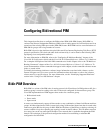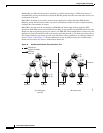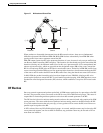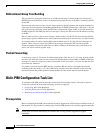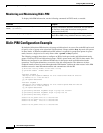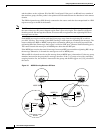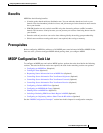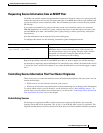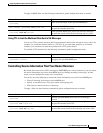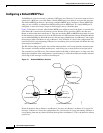
IPC-477
Cisco IOS IP Configuration Guide
Configuring Multicast Source Discovery Protocol
This chapter describes the Multicast Source Discovery Protocol (MSDP) feature. For a complete
description of the MSDP commands in this chapter, refer to the “Multicast Source Discovery Protocol
Commands” chapter of the Cisco IOS IP Command Reference, Volume 3 of 3: Multicast publication. To
locate documentation of other commands in this chapter, use the command reference master index, or
search online.
MSDP is a mechanism to connect multiple Protocol Independent Multicast sparse mode (PIM-SM)
domains. MSDP allows multicast sources for a group to be known to all rendezvous points (RPs) in
different domains. Each PIM-SM domain uses its own RPs and need not depend on RPs in other
domains. An RP runs MSDP over TCP to discover multicast sources in other domains.
An RP in a PIM-SM domain has an MSDP peering relationship with MSDP-enabled routers in another
domain. The peering relationship occurs over a TCP connection, where primarily a list of sources
sending to multicast groups is exchanged. The TCP connections between RPs are achieved by the
underlying routing system. The receiving RP uses the source lists to establish a source path.
The purpose of this topology is to have domains discover multicast sources in other domains. If the
multicast sources are of interest to a domain that has receivers, multicast data is delivered over the
normal, source-tree building mechanism in PIM-SM.
MSDP is also used to announce sources sending to a group. These announcements must originate at the
RP of the domain.
MSDP depends heavily on BGP or MBGP for interdomain operation. We recommend that you run
MSDP in RPs in your domain that are RPs for sources sending to global groups to be announced to the
internet.
To identify the hardware platform or software image information associated with a feature, use the
Feature Navigator on Cisco.com to search for information about the feature or refer to the software
release notes for a specific release. For more information, see the “Identifying Supported Platforms”
section in the “Using Cisco IOS Software” chapter.
How MSDP Works
Figure 78 illustrates MSDP operating between two MSDP peers. PIM uses MSDP as the standard
mechanism to register a source with the RP of a domain.
When MSDP is configured, the following sequence occurs. When the first data packet of a source is
registered by the first hop router, that same data packet is decapsulated by the RP and forwarded down
the shared tree. That packet is also reencapsulated in a Source-Active (SA) message that is immediately
forwarded to all MSDP peers. The SA message identifies the source, the group the source is sending to,





